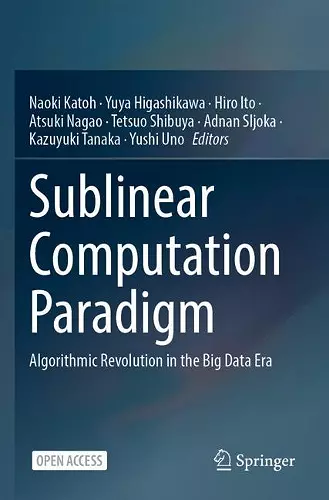Sublinear Computation Paradigm
Algorithmic Revolution in the Big Data Era
Hiro Ito editor Yushi Uno editor Kazuyuki Tanaka editor Naoki Katoh editor Yuya Higashikawa editor Atsuki Nagao editor Tetsuo Shibuya editor Adnan Sljoka editor
Format:Paperback
Publisher:Springer Verlag, Singapore
Published:20th Oct '21
Currently unavailable, our supplier has not provided us a restock date
This paperback is available in another edition too:
- Hardback£44.99(9789811640940)

This open access book gives an overview of cutting-edge work on a new paradigm called the “sublinear computation paradigm,” which was proposed in the large multiyear academic research project “Foundations of Innovative Algorithms for Big Data.” That project ran from October 2014 to March 2020, in Japan. To handle the unprecedented explosion of big data sets in research, industry, and other areas of society, there is an urgent need to develop novel methods and approaches for big data analysis. To meet this need, innovative changes in algorithm theory for big data are being pursued. For example, polynomial-time algorithms have thus far been regarded as “fast,” but if a quadratic-time algorithm is applied to a petabyte-scale or larger big data set, problems are encountered in terms of computational resources or running time. To deal with this critical computational and algorithmic bottleneck, linear, sublinear, and constant time algorithms are required.
The sublinear computation paradigm is proposed here in order to support innovation in the big data era. A foundation of innovative algorithms has been created by developing computational procedures, data structures, and modelling techniques for big data. The project is organized into three teams that focus on sublinear algorithms, sublinear data structures, and sublinear modelling. The work has provided high-level academic research results of strong computational and algorithmic interest, which are presented in this book.
The book consists of five parts: Part I, which consists of a single chapter on the concept of the sublinear computation paradigm; Parts II, III, and IV review results on sublinear algorithms, sublinear data structures, and sublinear modelling, respectively; Part V presents application results. The information presented here will inspire the researchers who work in the field of modern algorithms.
ISBN: 9789811640971
Dimensions: unknown
Weight: unknown
410 pages
1st ed. 2022